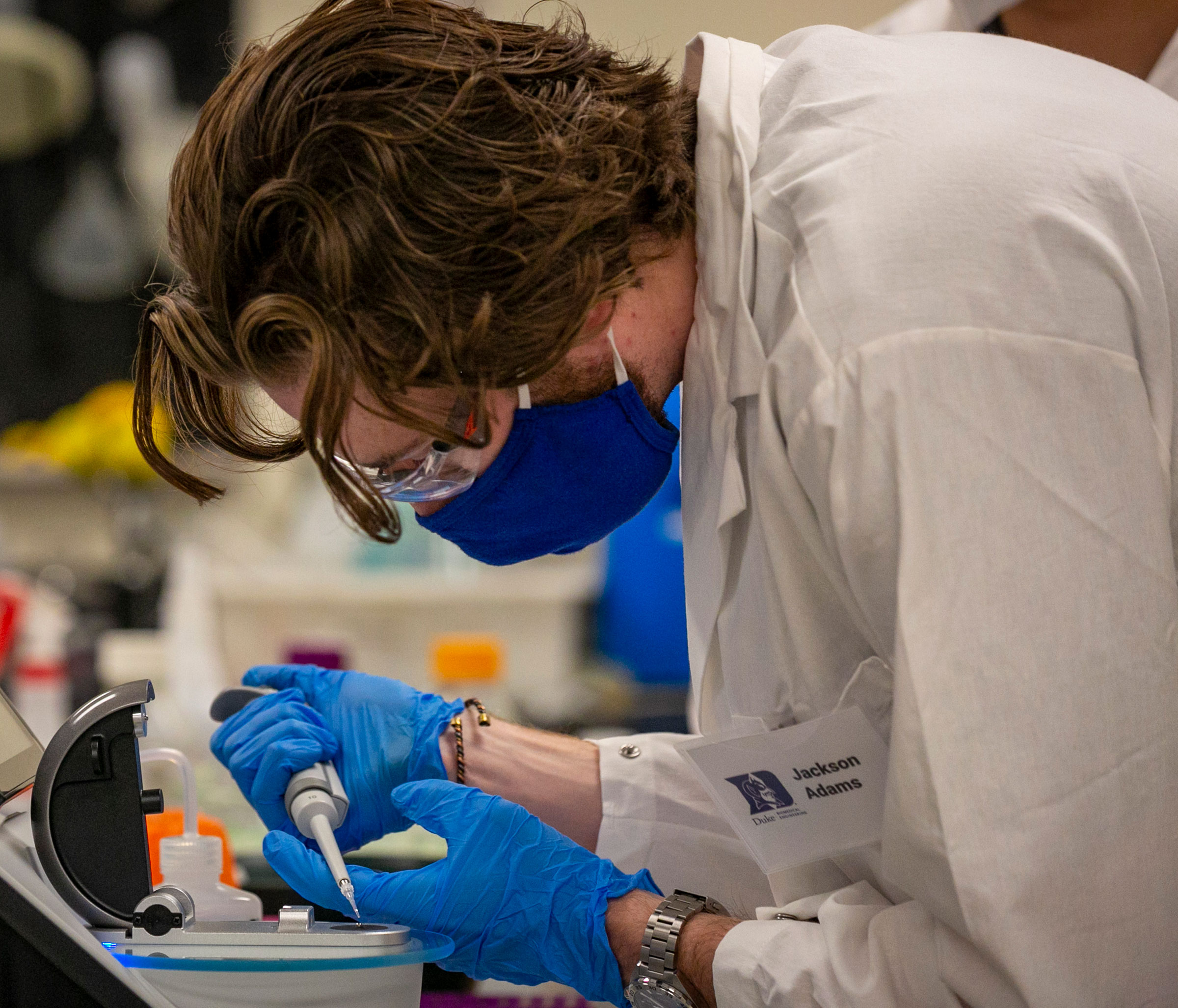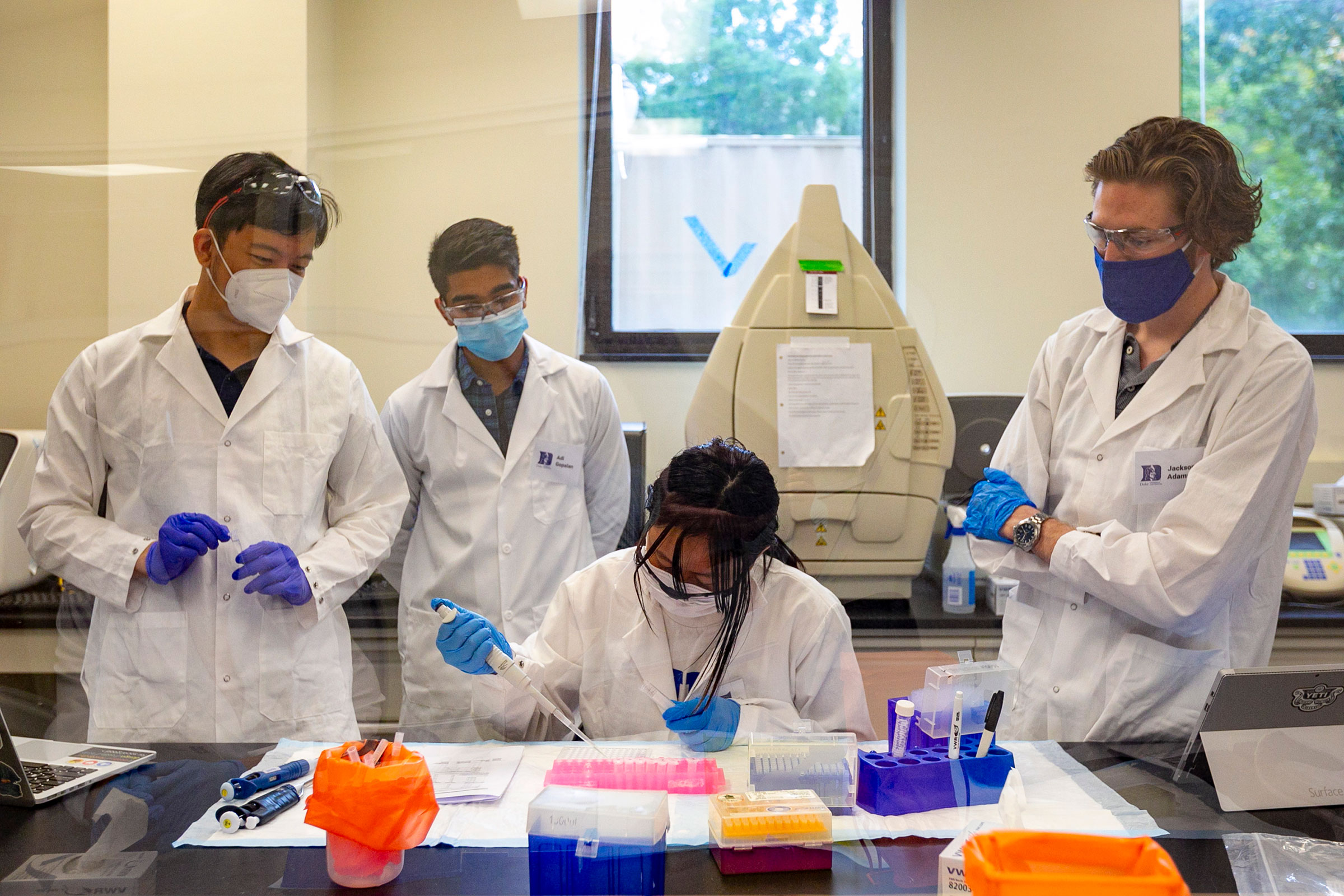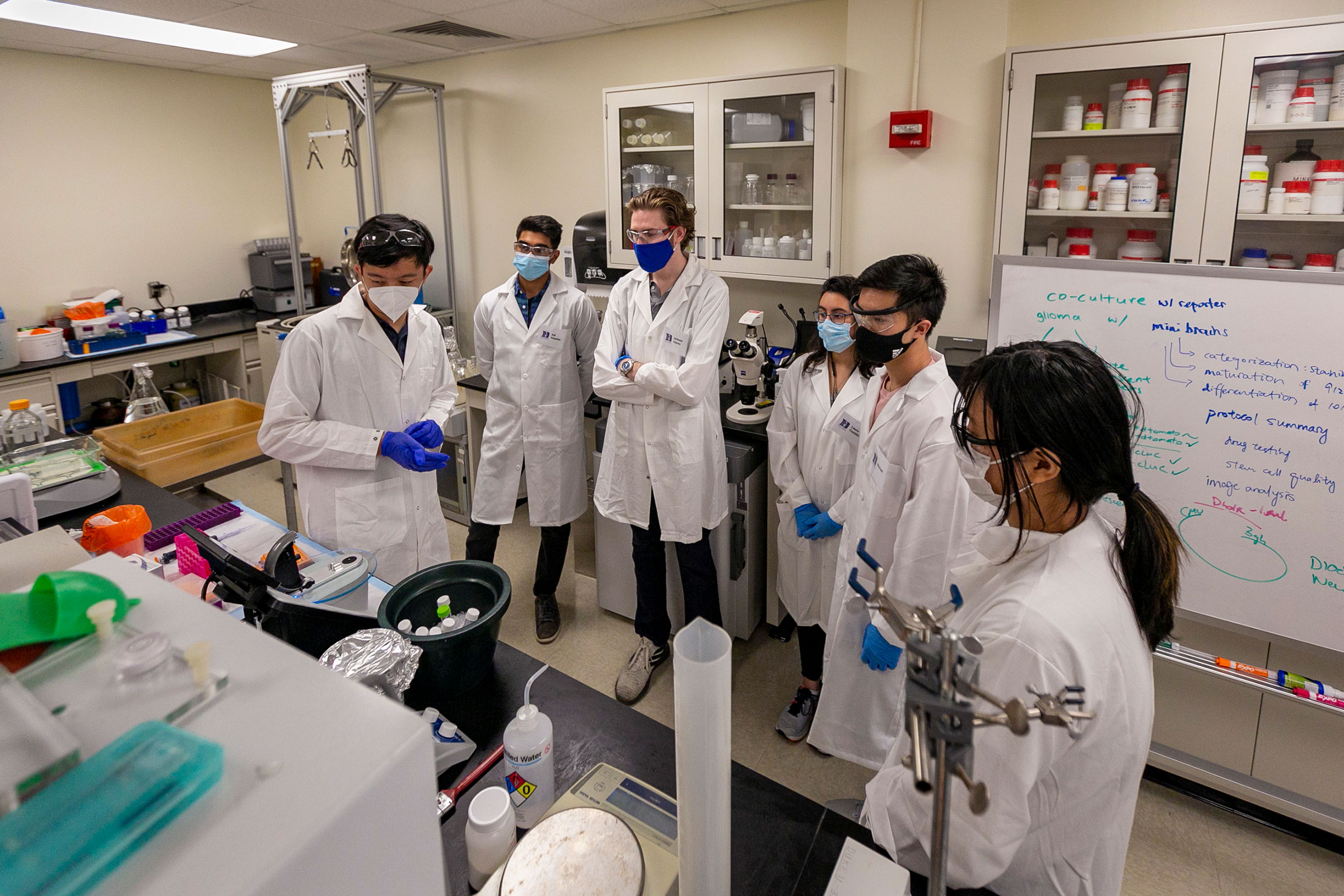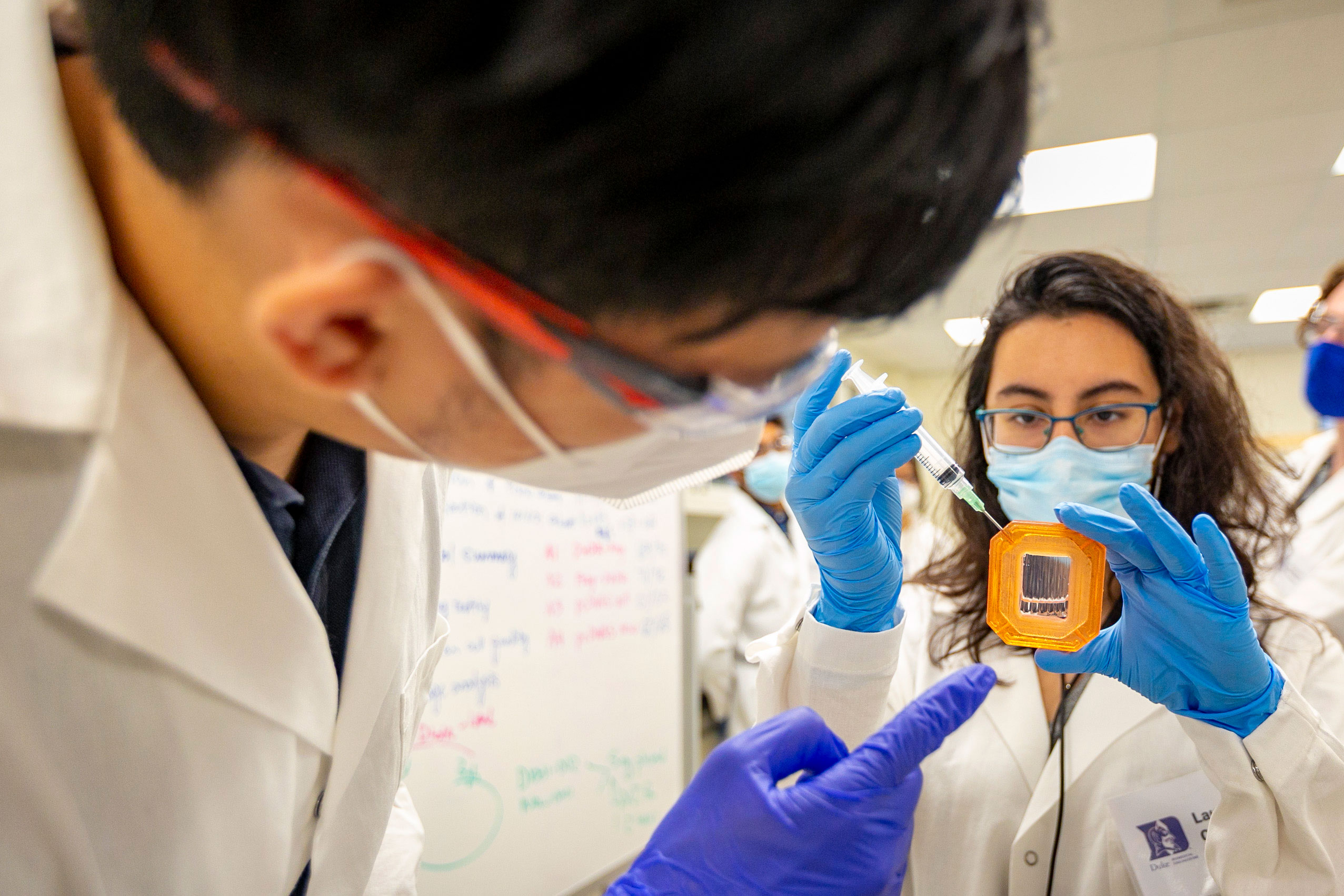Engineering the Duke BME Wet Lab Space
The Nello L. Teer Building is the first building that people walk by as they enter Duke University’s Harrington Engineering Quad from Science Drive. Unlike the neighboring Hudson Hall and Fitzpatrick Center for Interdisciplinary Engineering, Medicine and Applied Sciences, the Teer building’s façade doesn’t feature brick or the signature Duke stone. Instead, its gray concrete exterior harkens back to the 1980s, when the building was designed and built by Nello Leguy Teer.
Although the building itself is nearly 40 years old, its basement has undergone a transformation into a state-of-the-art wet lab space for biomedical engineering students at Duke.
THE BASEMENT LABS
According to Maggie Gatongi, a senior laboratory administrator in Duke BME, the department’s wet lab space used to consist of little more than a few lab benches and a one biosafety cabinet an isolated corner of the Teer basement.
“Working the lab space 10 years ago and working in the space now is like night and day,” Gatongi says. “Back then we had the bare minimum in terms of tools, and we only taught one or two classes in the space during the semester.”

Today, the BME wet labs span multiple rooms and workspaces across the bottom floor of the Teer building. Pipettes, microscopes, and an assortment of flasks, reagents and safety materials line the numerous tables and shelves throughout the space, and the number of biosafety cabinets has grown from one to six. The labs are bustling with activity throughout the day, and it’s not unusual to see the remnants of notes, equations or scribbles on the windows along the hallway, offering passersby a hint about the projects students are working on inside.
These updated spaces are now well stocked and maintained, but the biggest change involves the impressive row of machines that line the back wall of the lab.
“In the last ten years, the department really made growing the ‘wet and squishy’ aspect of BME a priority, so we’ve upped our game both in the classes that we’ve offered and in the tools that we’ve acquired,” says Matt Brown, the teaching laboratory manager in Duke BME. “We have several industry-level tools that are usually only available in specialized research labs, so it’s fairly unprecedented that we’re able to use them in undergraduate courses.”
One such device is the fast protein liquid chromatography (FPLC) machine, which helps students purify proteins they manufactured using bacteria or yeast.

“The pharmaceutical industry uses this machine on a massive scale because they need to manufacture and purify such a large number of proteins at once,” says Cameron Kim, an assistant professor of the practice in Duke BME. “But because our students have easy access to the FPLC, they get a jump start at being able to understand how to use the tool and become more comfortable with it. These machines are widely used in industry and in research, so knowing how to use this technology gives our students an immediate leg up on employment opportunities.”
In addition to the FPLC, the labs have also acquired fluorescence microscopes, which help them observe individual cells within tissue samples; a flow cytometer, which can quickly measure the size, structure and fluorescence of individual cells; and even two bioreactors, which is a large tool that can manufacture millions of cells at once.
“We have a lot of ‘toys’––a lot more than I’ve seen in the biotech spaces at other schools,” says Liz Feeney, a senior laboratory administrator in Duke BME. “It shows Duke BME’s investment in keeping their lab spaces up to date, but it also highlights the bigger changes in biomedical engineering overall. We’re seeing growing interest in medical device design and hardware, but there has been a push in molecular and cellular engineering work as well, so we’re bringing in tools that keep our students on the cutting edge of that work.”
These changes aren’t just about keeping students up to date with the latest technology. The lab team and faculty have also been working together to improve the existing lab curriculum and pioneer new programs and courses for Duke BME undergraduate and graduate students interested in the wet lab world.
“I spent nearly 15 to 20 hours a week in the wet lab space, and I think it’s extraordinarily unusual for undergraduates to have access to the level of technology that we have available in these labs,” says recent BME graduate John Boom. “Not only do I get to learn how to use these advanced instruments, but I also get to design and carry out custom projects with a team of undergrads that are also at my level. I learned more in that space than just about anywhere else.”

LEARNING AND LAB WORK


Steve Wallace teaches BME 244L: “Quantitative Physiology with Biostatistical Applications,” which is traditionally the first course BME students take in the wet lab space.
“Students learn how to use math to better understand things like organ systems and tissue functions,” says Wallace, a senior lecturing fellow in Duke BME. “Students say it’s the hardest class they take during their time at Duke, but they also say they learn the most during it because it’s just a whammy of all the concepts they’ll need as they advance through the department.”
The course is structured so that the lab sections complement ideas covered during the course lectures, which involve applied statistics, such as hypothesis testing and experimental design, along with quantitative physiology like how nerves send signals or how muscles contract. For example, after a lecture about nerve conduction velocity, students will go to a lab where they’ll attach electrodes to a partner’s arm and give them low level shocks. These shocks make the nerve propagate the signal to the muscle, which makes the students’ fingers twitch.
“The sensors on their hand allow students to quantify the muscle response to the stimulus on their ulnar nerve. Students continually increase the stimulus current until they have recruited all the muscle fibers to contract,” says Wallace. “Students then analyze the data using the statistical concepts from the lecture. The course is focused on applying statistics to biomedical data rather than keeping everything theoretical, and by essentially repeating the lecture-lab-analysis process we make sure to hammer home how to successfully run an experiment and analyze biological data.”
“One of the more memorable experiments in that class was the pee lab,” says Ella Gunady, a senior in BME and biology. “We would collect and test urine samples from students in our group, and it tied into what we learned about renal function and statistics from the lecture. I think about that class every time I pass by the bathroom in the BME teaching lab space!”
The foundational skills that students acquire in this course then feed into the core area lab classes they take during their junior year––specifically Cellular Engineering and the newly announced Molecular Engineering courses.
The Cellular Engineering course was developed by Wallace and Brent Hoffman, an associate professor in BME, to introduce students to more advanced aspects of biomedical engineering, like controlling cell function through genetic and protein engineering. According to Wallace, the lab component of the course was designed to not only observe and measure cellular responses discussed in the lecture but to help students feel more comfortable in a wet lab environment.
“Wet lab experience, specifically hands-on work with mammalian cells, as an undergraduate can be limited. I realized that a lot of the concepts and understanding I’d picked up about working in a cell culture lab came from graduate school and working with other graduate students,” says Wallace. “I wanted this course to resolve that gap, so we’ll teach the course concepts but, in the process, students will also learn the basics of working in a cell culture lab, like how to use a biological safety cabinet and how to develop a good sterile technique.”
Lab projects include completing mammalian cell assays to look at basic cell behavior, like rates of cell proliferation. They’ll learn how to maintain their cells for a week and develop a schedule to regularly visit the lab to feed the cells and track their progress. Students will also learn common end-point assays, like how to measure protein expression with a Western blot assay or how to measure mRNA levels with quantitative real-time PCR.
“The actin polymerization assay was my favorite experiment in Cellular Engineering, says rising senior Advaita Singh. “We could use fluorescence to view the actin under a microscope, and you could see how the cells behaved and grew when they were put into different types of substrates. It was amazing to see and think about how the setting affects the cells inside our body and in the experiments we do in the lab.”
Wallace also designed the lab experience to specifically teach students how to adapt when things go wrong. In one of the labs, students purposefully contaminate their cell cultures so they can learn to identify the different causes of contamination.
“Cellular engineering is my favorite class I’ve taken at Duke so far,” says Gunady, “I came into the class with some experience in basic lab techniques, but I loved learning about why those techniques work and how they can be applied to questions that bridge the gap between basic and applied science.”


Billed as the sister course to Cellular Engineering, the Molecular Engineering class will launch in the fall of 2022. Developed by Kim and Pranam Chatterjee, an assistant professor of biomedical engineering, the course will focus on the principles of engineering biomolecules.
“We want to show students how we as biomedical engineers can utilize a protein or a molecule for a variety of purposes,” explains Kim. “We want to teach the students how they can iterate and refine a protein, similar to how engineers would iterate and improve the design of a medical device. To be able to do that in the ‘wet space’ of biology is very critical.”
The course will draw on Chatterjee’s expertise in computational biology and enable students to use algorithms and screening methods to both identify and design new and existing proteins for specific purposes. Students will learn how to grow their target proteins and how to alter them for their intended use.
“By looking at the different proteins available, we want them to gain a better understanding of why one structure is better suited for one purpose, or why certain enzymes are useful while others are not,” says Kim. “Then, when they have this initial understanding, we want them to begin editing their protein computationally. Once they’re happy with their changes, we’ll order the materials for them to grow and alter that protein in the lab. Ideally, at the end of the semester, they’ll show why their altered design either worked or why it didn’t work.”
Wallace and Kim designed these courses to provide a strong foundation for students interested in the wet lab world, and to help students identify more specific interests within biomedical engineering. This will help students select the advanced lab courses they’ll take during their senior year, like Genome Engineering, Biotech Design, or Cellular Mechanics.
“For my Biotech Design class, we developed multiple design proposals covering everything from diagnostics to therapeutics to different kinds of devices that would help with environmental sustainability, and we then learned how to use synthetic biology and relevant biotech skills to pursue those projects,” says Boom. “I thought it was a fantastic class, because at no other point do you really get a chance to learn things like how to do cloning or how to take different pieces of DNA and splice them together to get a custom product. It was a great opportunity.”

THE PATH AHEAD
With the growing interest in the wet lab courses and space, the lab staff and faculty are finding that they are in danger of becoming victims of their own success.
“The addition of new equipment has also helped us address bottlenecks that previously slowed down the lab work. For example, we used to have a single biosafety cabinet, so students would need to wait on each other to get their work done,” says Gatongi. “Thankfully, that’s not an issue anymore, but as the number of lab sections grow and fill to capacity, we know that we’ll need to keep the lab space growing to meet student interest.”
Although the lab faculty and staff know that they’ll need to keep adding equipment, classes and space to ensure that they are always meeting student needs, the team is thrilled with the progress they’ve witnessed over the last decade.
“In the past, one of the main ways students got wet lab experience was by working in a research lab,” says Kim. “While that’s a great opportunity, it isn’t always accessible for students, especially if they have full-time jobs or a demanding course load. But because we’ve built this powerhouse lab and are developing an innovative curriculum, students can get very comprehensive lab experiences that will set them up for success after graduation.”




